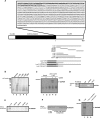Posttranscriptional regulation of angiotensin II type 1 receptor expression by glyceraldehyde 3-phosphate dehydrogenase
- PMID: 19246543
- PMCID: PMC2673440
- DOI: 10.1093/nar/gkp098
Posttranscriptional regulation of angiotensin II type 1 receptor expression by glyceraldehyde 3-phosphate dehydrogenase
Abstract
Regulation of angiotensin II type 1 receptor (AT1R) has a pathophysiological role in hypertension, atherosclerosis and heart failure. We started from an observation that the 3'-untranslated region (3'-UTR) of AT1R mRNA suppressed AT1R translation. Using affinity purification for the separation of 3'-UTR-binding proteins and mass spectrometry for their identification, we describe glyceraldehyde 3-phosphate dehydrogenase (GAPDH) as an AT1R 3'-UTR-binding protein. RNA electrophoretic mobility shift analysis with purified GAPDH further demonstrated a direct interaction with the 3'-UTR while GAPDH immunoprecipitation confirmed this interaction with endogenous AT1R mRNA. GAPDH-binding site was mapped to 1-100 of 3'-UTR. GAPDH-bound target mRNAs were identified by expression array hybridization. Analysis of secondary structures shared among GAPDH targets led to the identification of a RNA motif rich in adenines and uracils. Silencing of GAPDH increased the expression of both endogenous and transfected AT1R. Similarly, a decrease in GAPDH expression by H(2)O(2) led to an increased level of AT1R expression. Consistent with GAPDH having a central role in H(2)O(2)-mediated AT1R regulation, both the deletion of GAPDH-binding site and GAPDH overexpression attenuated the effect of H(2)O(2) on AT1R mRNA. Taken together, GAPDH is a translational suppressor of AT1R and mediates the effect of H(2)O(2) on AT1R mRNA.
Figures






Similar articles
-
Endoplasmic reticulum stress increases AT1R mRNA expression via TIA-1-dependent mechanism.Nucleic Acids Res. 2016 Apr 20;44(7):3095-104. doi: 10.1093/nar/gkv1368. Epub 2015 Dec 17. Nucleic Acids Res. 2016. PMID: 26681690 Free PMC article.
-
p100 increases AT1R expression through interaction with AT1R 3'-UTR.Nucleic Acids Res. 2008 Aug;36(13):4474-87. doi: 10.1093/nar/gkn411. Epub 2008 Jul 4. Nucleic Acids Res. 2008. PMID: 18603592 Free PMC article.
-
Regulation of AT1R expression through HuR by insulin.Nucleic Acids Res. 2012 Jul;40(12):5250-61. doi: 10.1093/nar/gks170. Epub 2012 Feb 23. Nucleic Acids Res. 2012. PMID: 22362742 Free PMC article.
-
The sweet side of RNA regulation: glyceraldehyde-3-phosphate dehydrogenase as a noncanonical RNA-binding protein.Wiley Interdiscip Rev RNA. 2016 Jan-Feb;7(1):53-70. doi: 10.1002/wrna.1315. Epub 2015 Nov 12. Wiley Interdiscip Rev RNA. 2016. PMID: 26564736 Free PMC article. Review.
-
GAPDH as a model non-canonical AU-rich RNA binding protein.Semin Cell Dev Biol. 2019 Feb;86:162-173. doi: 10.1016/j.semcdb.2018.03.013. Epub 2018 Mar 24. Semin Cell Dev Biol. 2019. PMID: 29574117 Review.
Cited by
-
Identification of a plant-specific Zn2+-sensitive ribonuclease activity.Planta. 2009 Sep;230(4):819-25. doi: 10.1007/s00425-009-0986-3. Epub 2009 Jul 28. Planta. 2009. PMID: 19636588
-
Endoplasmic reticulum stress increases AT1R mRNA expression via TIA-1-dependent mechanism.Nucleic Acids Res. 2016 Apr 20;44(7):3095-104. doi: 10.1093/nar/gkv1368. Epub 2015 Dec 17. Nucleic Acids Res. 2016. PMID: 26681690 Free PMC article.
-
Subcellular dynamics of multifunctional protein regulation: mechanisms of GAPDH intracellular translocation.J Cell Biochem. 2012 Jul;113(7):2193-200. doi: 10.1002/jcb.24113. J Cell Biochem. 2012. PMID: 22388977 Free PMC article. Review.
-
Extracellular vesicles rich in HAX1 promote angiogenesis by modulating ITGB6 translation.J Extracell Vesicles. 2022 May;11(5):e12221. doi: 10.1002/jev2.12221. J Extracell Vesicles. 2022. PMID: 35524442 Free PMC article.
-
A dedicated glyceraldehyde-3-phosphate dehydrogenase is involved in the biosynthesis of volatile sesquiterpenes in Trichoderma virens-evidence for the role of a fungal GAPDH in secondary metabolism.Curr Genet. 2019 Feb;65(1):243-252. doi: 10.1007/s00294-018-0868-y. Epub 2018 Jul 25. Curr Genet. 2019. PMID: 30046843
References
-
- Dzau V. The cardiovascular continuum and renin-angiotensin-aldosterone system blockade. J. Hypertens. Suppl. 2005;23:S9–S17. - PubMed
-
- Horiuchi M, Akishita M, Dzau VJ. Recent progress in angiotensin II type 2 receptor research in the cardiovascular system. Hypertension. 1999;33:613–621. - PubMed
-
- Lehtonen JY, Daviet L, Nahmias C, Horiuchi M, Dzau VJ. Analysis of functional domains of angiotensin II type 2 receptor involved in apoptosis. Mol. Endocrinol. 1999;13:1051–1060. - PubMed
-
- Daviet L, Lehtonen JY, Tamura K, Griese DP, Horiuchi M, Dzau VJ. Cloning and characterization of ATRAP, a novel protein that interacts with the angiotensin II type 1 receptor. J. Biol. Chem. 1999;274:17058–17062. - PubMed
-
- Elton TS, Martin MM. Angiotensin II type 1 receptor gene regulation: transcriptional and posttranscriptional mechanisms. Hypertension. 2007;49:953–961. - PubMed
Publication types
MeSH terms
Substances
LinkOut - more resources
Full Text Sources
Research Materials

